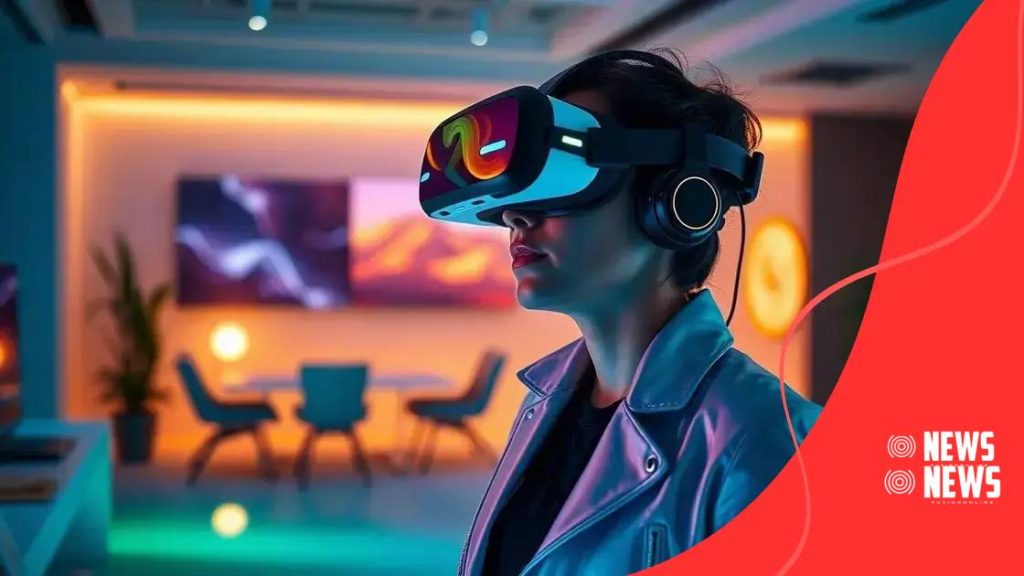Virtual reality in journalism: immersive storytelling techniques

Virtual reality in journalism enhances storytelling by creating immersive experiences that engage audiences and evoke emotional responses to news, transforming how stories are told and consumed.
Have you ever wondered how virtual reality in journalism can change the way we consume news? This innovative technology offers journalists a unique canvas to create immersive stories that resonate deeply with audiences. Let’s delve into how VR is reshaping the landscape of journalism.
Understanding virtual reality in journalism
Understanding virtual reality in journalism is essential as it transforms the way stories are told. This technology allows journalists to immerse their audiences in narratives, bringing them closer to the experiences being reported. Imagine being able to step inside a news story, feeling as though you are right there with the subjects.
Virtual reality (VR) creates a unique interaction between the audience and the story. This level of engagement can make news more compelling and memorable. By utilizing VR, journalists can present a multi-dimensional view of events that traditional media cannot offer.
Benefits of virtual reality
There are several key benefits of using VR in journalism:
- Enhanced engagement: Audiences are more likely to pay attention to immersive content.
- Emotional connection: VR allows viewers to empathize with the subjects of their stories.
- New storytelling possibilities: Journalists can convey complex issues through interactive and immersive experiences.
Moreover, as technology advances, the potential for virtual reality journalism continues to expand. From showcasing significant global events to everyday local news, the applications are limitless. The need for engaging, credible journalism has never been more urgent. That’s why understanding and embracing VR in journalism can set news organizations apart in a competitive landscape.
How VR works
Using VR technology typically involves special equipment like headsets, which transport users into a virtual environment. These headsets create a 360-degree view where every direction reveals part of the story. Additionally, journalists can use VR to create interactive features, allowing users to control aspects of their experience.
Impressively, VR journalism can take many forms—from reports on war zones to explorations of environmental issues. By making complex subjects accessible, journalists can broaden understanding and promote awareness.
Benefits of immersive storytelling techniques
The benefits of immersive storytelling techniques in journalism are substantial. These methods allow journalists to captivate their audience in ways traditional reporting cannot. By engaging the senses and evoking emotions, immersive storytelling makes news more relatable.
One of the main advantages is that immersive techniques enhance audience engagement. People interact with stories on a deeper level, making them more likely to remember the content. Additionally, immersive storytelling can create a strong emotional response, which helps viewers connect with the narrative’s characters and situations.
Key benefits of immersive storytelling
Here are some of the key benefits that come from using immersive storytelling techniques:
- Increased empathy: Viewers gain a better understanding of others’ experiences.
- Memorable experiences: Immersive stories leave a lasting impact on the audience.
- Creative expression: Journalists can present stories in innovative and engaging formats.
As audiences become more accustomed to interactive and engaging content, the demand for immersive experiences in news reporting will likely grow. The capability of journalists to draw viewers into a story transforms the way information is conveyed. Through virtual reality and interactive media, immersive storytelling techniques bridge the gap between mere observation and genuine experience.
Unlocking new opportunities
By adopting immersive storytelling, journalists can unlock new opportunities to address critical issues. For instance, when covering complex topics like climate change or humanitarian crises, these techniques can break down barriers and make difficult subjects accessible. This approach not only informs but also empowers audiences to take action.
As VR and AR technologies continue to evolve, the possibilities for immersive storytelling will expand. Journalists who embrace these techniques can lead the way in redefining how stories are told and consumed in the digital age.
Tools and equipment for VR journalism

Having the right tools and equipment for VR journalism is crucial for creating captivating immersive experiences. These technologies allow journalists to transport audiences into their stories, providing a more engaging way to consume news. Understanding the specific tools available and their applications can enhance storytelling.
At the core of VR journalism are headsets. These devices immerse users in a virtual environment, offering a 360-degree view of the content. Popular headsets like Oculus Rift, HTC Vive, and newer models like the Meta Quest provide high-quality experiences that are becoming increasingly accessible.
Key equipment for VR journalism
Some essential pieces of equipment you’ll need include:
- 360-degree cameras: These cameras capture the full surroundings, making the immersive experience possible.
- Computer or mobile devices: High-performance systems are often required to process VR content smoothly.
- Audio equipment: Surround sound systems or spatial audio technology enhance the viewer’s experience.
- VR software: Programs for editing and creating VR content are crucial for developing new stories.
In addition to hardware, having the right software is vital for VR journalism. Applications like Unity and Unreal Engine enable journalists to design and develop immersive stories. These platforms provide the necessary tools to integrate audio, visuals, and interactive elements, making the storytelling experience richer.
Moreover, cloud-based services are becoming popular as they allow journalists to store and share large VR files efficiently. This is especially important when collaborating with teams or distributing content to wider audiences.
Future technology in VR journalism
As technology advances, tools for VR journalism are also evolving. Innovations like improved resolution, better motion tracking, and wireless connectivity will expand the possibilities for immersive storytelling. These advancements are essential for delivering high-quality experiences that captivate viewers.
As more journalists begin to adopt VR in their practices, staying updated on the latest tools and equipment will be key to creating impactful stories that resonate.
Case studies of effective VR news stories
Exploring case studies of effective VR news stories reveals how immersive storytelling can impact audiences significantly. Various news outlets have successfully adopted VR to enhance their reporting. Let’s look at some examples that highlight the effectiveness of this medium.
One notable case is the “The Displaced”, a VR experience by The New York Times. This project provides a glimpse into the lives of children displaced by conflict. Viewers step into the shoes of refugee children, experiencing their challenges firsthand. This immersive narrative not only informs but also fosters empathy.
Other impactful VR news stories
Several other powerful examples demonstrate the potential of VR in journalism:
- “Traveling While Black”: This VR experience allows users to navigate through the past and present challenges faced by Black travelers in America. It includes interactive elements, enhancing emotional connection.
- “The Last Goodbye”: Produced by the VR company Emblematic Group, this experience lets users witness important moments in a loved one’s life, aiming to evoke strong emotional responses and allowing conversations about loss.
- “The Invisible Man”: This piece creates awareness about the struggles of homeless individuals by enabling the audience to see the world through their eyes. It invites viewers to feel the impact of their environment and decisions.
The success of these projects highlights how VR can convey stories that resonate with audiences. By immersing viewers in new realities, journalists can transport them beyond traditional media limitations. This storytelling method emphasizes understanding and connection, making a lasting impact.
As more media organizations explore VR, it becomes clear that effective news reporting can not only inform but also inspire change. These case studies serve as a model for future storytelling in journalism, demonstrating the power of immersive experiences to bridge gaps in understanding.
Future trends in virtual reality for journalism
The future trends in virtual reality for journalism promise exciting developments that will shape the way stories are told. As technology evolves, journalists can expect more innovative tools and methods that enhance storytelling and audience engagement.
One trend is the growing use of artificial intelligence to personalize VR experiences. AI algorithms can analyze viewer preferences and habits, tailoring content to fit individual needs. This personal touch can increase engagement and make stories more impactful.
Emerging technologies
Emerging technologies such as augmented reality (AR) are also expected to play a significant role in journalism. By blending digital content with the real world, AR can provide layers of information without disconnecting the viewer from their environment. This means during a news event, users can see real-time data and visuals overlaying what they are witnessing.
- Improved accessibility: New devices will make VR much more accessible to the general public.
- Enhanced interactivity: Audiences will engage more directly with stories through interactive elements, making them part of the narrative.
- Higher fidelity visuals: Advances in graphics technology will allow for even more realistic and detailed immersive experiences.
Moreover, partnerships between tech companies and news organizations can drive innovation. By collaborating, they can create custom VR content that addresses specific social issues or educational needs. This not only enhances journalistic storytelling but also helps communities understand complex topics more deeply.
The future of VR journalism also includes more data storytelling. Using VR to visualize complex data can help demystify statistical information. For instance, presenting climate change data through immersive experiences can create a stronger emotional connection with the audience.
Ethics and challenges
As these trends emerge, ethical considerations will become more critical. Journalists must ensure they balance immersive storytelling with accuracy and truth. As with any new technology, the potential for misinformation is a concern that must be addressed. Therefore, as VR continues to grow in journalism, maintaining credibility will remain a priority.
FAQ – Frequently Asked Questions about Virtual Reality in Journalism
How does virtual reality enhance storytelling in journalism?
Virtual reality allows journalists to create immersive experiences that engage audiences on deeper levels, making news more impactful.
What are some effective case studies of VR in journalism?
Examples include ‘The Displaced’ and ‘Traveling While Black’, which showcase how VR can evoke empathy and bring attention to important issues.
What tools and equipment are necessary for VR journalism?
Essential tools include 360-degree cameras, VR headsets, high-performance computers, and specialized software for creating immersive content.
What future trends should we expect in VR journalism?
Expect advancements in AI personalization, augmented reality integration, and increased interactivity, which will enhance how stories are told.





